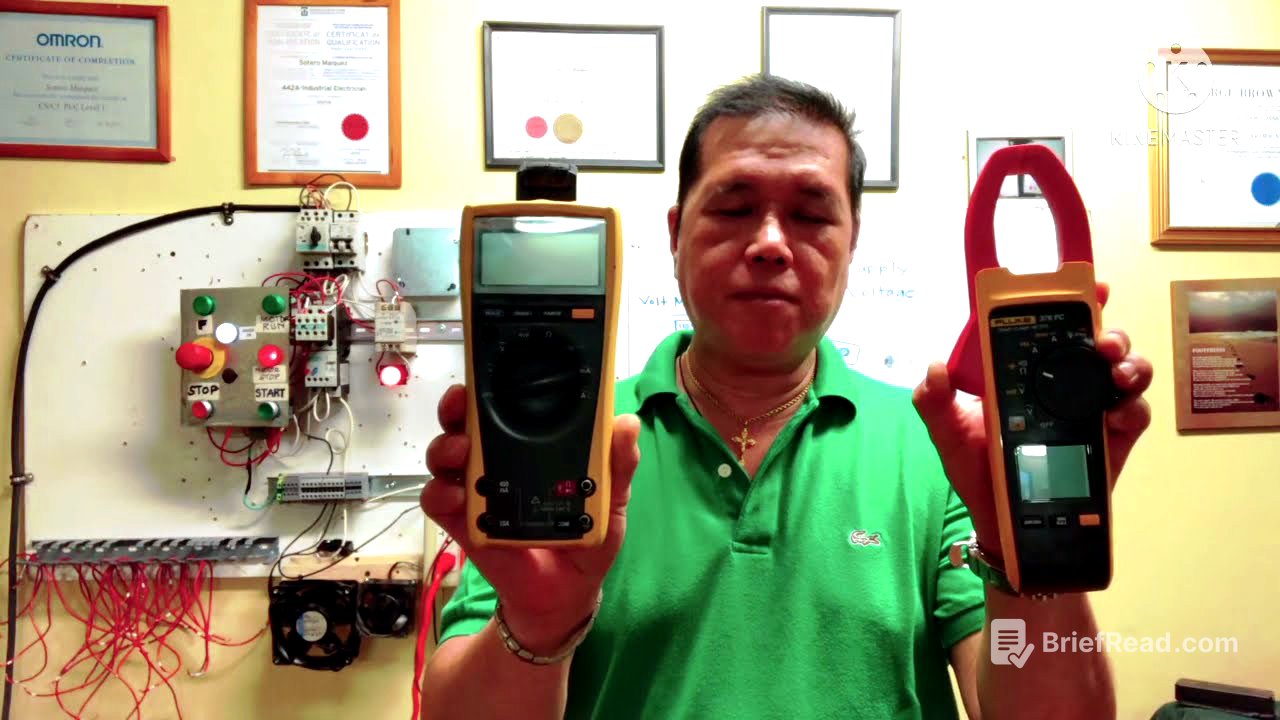TLDR;
This video provides a tutorial on how to use a multimeter and a clamp meter for electrical testing. It covers measuring voltage (AC and DC), checking continuity, testing fuses, and measuring current. The video also explains how to use the hold function, backlight, and how to check motor windings for balance and grounding.
- Explains the functions of a multimeter and clamp meter.
- Demonstrates how to measure voltage, current, and continuity.
- Shows how to test fuses and motor windings.
Introduction to Multimeters and Clamp Meters [0:05]
The video introduces the use of multimeters and clamp meters, highlighting their similarities and differences. Both devices can measure AC/DC voltage and continuity, but clamp meters are specifically designed to measure current by clamping onto a wire. The tutorial aims to guide beginners on how to effectively use these tools for various electrical measurements.
Understanding Multimeter Functions [0:32]
The video explains the various settings and functions of a multimeter. It details how to select the appropriate mode for measuring AC and DC voltage, resistance (Ohms), and continuity. The multimeter also features settings for testing diodes, a backlight for better visibility, a hold function to freeze readings, and range selection for different measurement scales.
Measuring Voltage with a Multimeter [2:42]
The tutorial demonstrates how to measure AC and DC voltage using a multimeter. For AC voltage, the selector switch is set to AC, and the test leads are placed on the hot and neutral wires. For DC voltage, the switch is set to DC, and the red (positive) and black (negative) leads are connected to the corresponding terminals of a DC source, such as a battery.
Testing Continuity and Fuses [3:53]
The video explains how to use the continuity function on a multimeter to check if a circuit is complete or if a fuse is intact. When the test leads are connected and the multimeter beeps or shows a low resistance reading (e.g., 0.3 ohms), it indicates continuity. This function can also be used to test wires for breaks or poor connections.
Testing Light Bulbs and Contacts [5:31]
The video demonstrates how to test light bulbs and electrical contacts using the multimeter's continuity and resistance functions. A good reading indicates that the light bulb filament is intact or that the contact is properly closed. The video also explains how to differentiate between normally closed and normally open contacts using these functions.
Checking Motor Windings [7:17]
The video explains how to check motor windings for balance and grounding using a multimeter. To check for balance, the resistance between each pair of windings is measured and compared; balanced windings should have similar resistance values. To check for grounding, the resistance between each winding and the motor's ground is measured; a high resistance indicates that the motor is not grounded.
Using Additional Multimeter Features [8:50]
The video demonstrates how to use additional features of the multimeter, such as measuring frequency (Hertz), using the hold function to freeze readings, and using the backlight for better visibility in dark environments. It also shows how to use the continuity function to identify broken wires or loose connections in a hot water cord.
Introduction to Clamp Meters [11:27]
The video transitions to explaining the use of a clamp meter, highlighting its ability to measure current without breaking the circuit. It also demonstrates how to measure voltage and continuity using the clamp meter's test leads, similar to a multimeter. The clamp meter is shown being used to test fuses and electrical contacts.
Measuring Current with a Clamp Meter [13:46]
The video demonstrates how to measure current using a clamp meter. The meter is set to AC amps, and the clamp is placed around a single wire to measure the current flowing through it. The video shows how to measure the current of a motor and explains that measuring multiple wires simultaneously will result in a zero reading.
Using Flexible Cable Clamp Meters [15:38]
The video introduces the use of flexible cable clamp meters for measuring current in situations where there are many cables or large wires that a standard clamp meter cannot accommodate. The flexible cable is wrapped around the wire, and the meter displays the current reading. This type of meter is particularly useful in power plants and other industrial settings.
